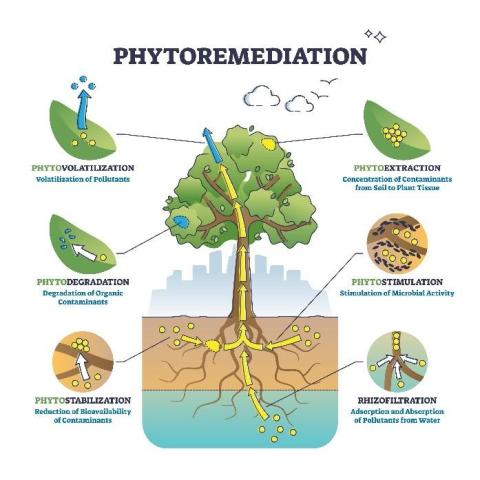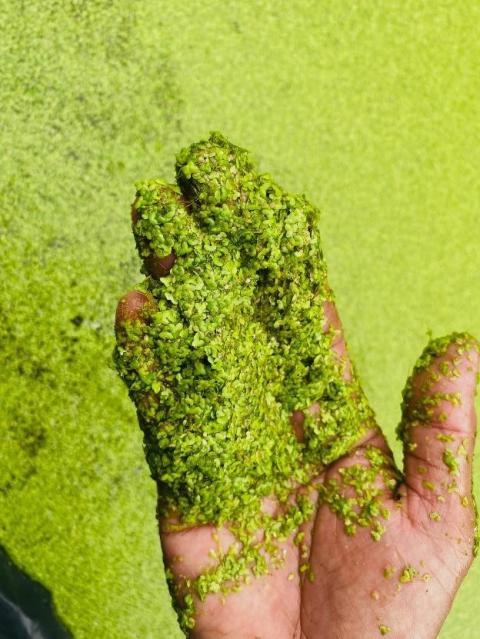Dr Natalie Meades: IBERS, KEHub, Aberystwyth University.
April 2024
Phytoremediation is a green technology that involves the use of plants to remove toxic components or contaminants from either the air, within soil or from aqueous solutions.
Phytoremediation offers the potential to purify nutrient rich waters such as liquid manures, slurries and agricultural wastewaters, thereby giving the purified water the potential to be safely discharged into the environment or to be re-used within systems.
The aquatic plant duckweed (Lemna L.) has demonstrated the potential to grow on nutrient rich waters and purify them. Moreover, the resultant plant biomass has demonstrated potential to act as a high protein feed for livestock and in aquaculture and as a feedstock for bioenergy production.
Phytoremediation is described as a green technology that uses plants to remove toxic components or contaminants from either the air, within soil or from aqueous solutions. Plants act in a number of ways by removing, destroying, sequestering, extracting, remediating, up taking, immobilising or stabilising components, through processes such as phytoextraction, phytostabilization, phytovolatilization, phytotransformation or rhizofiltration. Table 1 details the definitions of these key terms.
There is great interest with regards to the use of phytoremediation in the management of industrial, urban and agricultural waste materials. This technology can be seen as appealing due to low costs associated and the sustainability of practice. Moreover, this technology has the potential to be integrated into a circular economy where components and contaminants can be removed from the environment and resources recycled, repurposed or repaired for future use within systems. Details on the concept of circular economy can be found in previous technical articles discussing the role of circular economies for livestock and energy in agriculture. This technical article will explore the potential for the phytoremediation of agricultural wastewaters and how this practice has the potential to fit within a circular economy with focus on Duckweed.
|
Table 1: Definitions of different phytoremediation processes, as presented by Rahman and Hasegawa (2011). |
|
|
Phytoextraction/ phytoaccumulation |
Plants uptake components or contaminants from the soil or from water and translocate and store them in their biomass.
|
|
Phytostabilisation |
Plants act by reducing the mobility and phytoavailability of components or contaminants within an environment.
|
|
Phytovolatilization |
Plants that are described to be hyperaccumulating, uptake components from the soil or water, translocate them to the aerial regions of the plants and volatilize them so they are lost to the air.
|
|
Phytotransformation |
Plants that are described to be hyperaccumulating are able to modify, inactivate, degrade (phytodegradation), or immobilise (phytostabilization) components through their metabolism as part of defence mechanisms.
|
|
Rhizofiltration |
Aquatic plants that are described to be hyperaccumulating, adsorb and absorb pollutants from aquatic environments such as water and wastewater. |
Duckweed
The aquatic plant Duckweed (Lemna L., sub-family Lemnnaceae, family Araceae) has received attention with regards to its phytoremediation ability. Duckweed is a perennial aquatic macrophyte that is part of the Lemna family, in which there are reported to be two sub-families (Lemnoidea and Wolffioideae) with five different genera (Spirodella, Lemna, Landoltia, Wolffia and Wolffiella) and at least 40 species. In the UK duckweed (Lemna minor, Lemna gibba) is a native freshwater plant although certain species have been introduced into the UK (Lemna minuta). The plant itself consists of fronds (leaves) with a single root or rootlet with no stem, that grow as a mat either on top of or below surface water.
Duckweed has been observed to successfully grow on nutrient rich waters of pH 5 – 9, at temperatures of 6 – 33oC and at depths of 0.5 m. Therefore, there is interest with regards to the potential of duckweed for the purification of agricultural effluent. In this instance agricultural effluent includes liquid slurries, liquid manures and agricultural wastewaters such as the liquid fraction following slurry separation, wastewater from washing equipment/ housing and the liquid fraction of digestate from anaerobic digesters. Duckweed can therefore be used to valorise agricultural effluent by purifying nutrient rich waters and producing a biomass which can be utilised as a high protein animal feed or as a feedstock for bioenergy production.
Agricultural Effluent as a Growth Media for Duckweed
For duckweed to successfully grow adequate sources of carbon dioxide, light and nutrients are required. With regards to nutrient provision, it has been identified that the macronutrients, nitrogen (N) and phosphate (P) have strong influence on duckweed growth. Moreover, it has been reported that duckweed requires approximately 60 mg/ L of N and a minimum of 1 mg/ L of P for growth. As such, liquid slurries, liquid manures and agricultural wastewater can be considered an ideal growth media for duckweed. In fact, studies using pig slurry, cattle slurry, diluted chicken manure and effluent from biodigesters have demonstrated positive results under experimental conditions, in terms of the removal of nutrients from such wastewaters, duckweed growth and resultant biomass yields.
Although liquid manures and slurries have been demonstrated to be a suitable growth media for duckweed, studies utilising such media have involved dilution first. This is due to the concentration of nutrients within raw liquid manure and slurry being too concentrated and therefore toxic to duckweed at current levels. A study investigated the effect of three different concentrations (low 1:16 w/v; medium 1:12 w/v; and high 1:8 w/v) of diluted chicken manure on the performance of duckweed (Lemna minor). The results of the study demonstrated duckweed to have the highest growth rates at the lowest concentration (1.85 g DM/ m2), intermediate growth rates at the medium concentration (0.88 g DM/ m2) and observed no growth at the highest concentration. Likewise, a study investigated the effect of different concentrations of nutrients within pig slurry (very high (2%, 1.5%, 1%), optimal (0.75%, 0.5%, 0.25%) and deficient (0.03%, 0.06%, 0.12%)) on the growth potential of duckweed (Lemna minor) over a 30-day period. The results of the study demonstrated duckweed to not grow in media of the highest and lowest nutrient concentrations. Furthermore, duckweed yield was described to be satisfactory at nutrient concentrations of 1% - 0.5%. As such, for raw liquid manure and slurry to be utilised as a growth media for duckweed it may require dilution first. A potential issue with this is that for dilution to occur, additional water use is required as well as needing a greater capacity to store material, which is neither a practical nor sustainable option.
However, recent research has demonstrated the pH of the growth media in which duckweed grows on to play an important role in duckweeds tolerance to high concentrations of nutrients. It has been demonstrated that the optimal pH for duckweed growth is around pH 6.5 – 7.5 and the typical pH of raw livestock slurry is alkaline and between 7.2 – 7.9. The acidification of liquid manure and slurry has been demonstrated to have promising effects with regards to duckweed survival and growth on nutrient rich waters. Moreover, a study demonstrated the acidification of the liquid fraction of cattle slurry following screw press separation to have positive effects on the growth rate of duckweed (Lemna minor). In this study, duckweed was able to grow successfully on media with a pH of 6.5 and ammoniacal-N concentrations of 293.3 mg/L, whereas duckweed did not grow on media with a pH of 8.2 and a much lower ammoniacal-N concentration of 65 mg/L. Moreover, a follow up study using diluted raw cattle slurry as a growth media, aimed to investigate the effect of slurry acidification on nutrient uptake by duckweed (Lemna minor). In this study duckweed was grown on raw cattle slurry of pH 8.67 diluted 1:20 to achieve an ammoniacal-N concentration of 57.44 mg/ L and compared to L. Lemna growing on the same diluted raw slurry acidified to pH 6.96 containing 58.76 mg/ L ammoniacal-N. The results of the study demonstrated the acidification of the raw diluted slurry to result in greater growth rates of the duckweed. Moreover, duckweed grown on acidified slurry displayed greater uptakes of nitrogen and phosphorus in comparison to the control treatment.
Duckweed as an Animal Feed
Duckweed has received attention from the agri-food industry, where it has been demonstrated to have the potential to act as a nutritious food resource for livestock and in aquaculture. The reproductive behaviour of duckweed is described as vegetative, as such, it is fast growing and high yielding which is beneficial in terms of food production. To put this into perspective, under optimal conditions duckweed has been demonstrated to have the potential to double its biomass within 16 - 48 hours. As such duckweed requires regular maintenance to maintain health and productivity which often involves the physical or mechanical removal of duckweed on a regular basis. A study involving the use of diluted chicken manure as a growth media for duckweed, observed duckweed yield to double following management in which 25% and 75% of total duckweed cover was removed.
The typical dry matter content of duckweed is thought to range between 3 - 14 % and based on a dry matter basis the nutritional composition of duckweed has been reported to have a protein content of 7 – 45%, a lipid content of 2 - 9 %, a fibre content of 12 – 28 % and a carbohydrate content of 14 – 44%. The protein content of duckweed has received attention, owing to its amino acid profile where duckweed has been reported to contain essential amino acids in varying proportions. In particular, duckweed is reported to contain high concentrations of leucine, threonine, valine, phenylalanine and lysine, with methionine and lysine concentrations being high in comparison to plant proteins with some stating that levels are close to that of animal protein. As such there is interest from the livestock feed industry with regards to the potential of duckweed acting as an alternative protein to conventional protein sources such as soya. Moreover, due to the growth behaviour of duckweed, it has been estimated that duckweed has the potential to produce protein 6 – 10 times as fast as that of an equivalent area planted with soya. The fatty acid profile of duckweed has also received attention, where it has been demonstrated that 80% of the total fatty acid profile of duckweed contains varying proportions of palmitic acid, linoleic acid and α-linolenic acid, which have been demonstrated to have health benefits. However, the nutritional composition of duckweed is dependent on a range of factors such as, the species of duckweed, quality of growth media, growing conditions and its management. For example a study reported duckweed grown on media with low nutrient concentrations to have a protein content ranging between 9 - 20% and a lipid content between 1.8 – 2.5%, however in nutrient rich media the protein composition was observed to range between 24–41% and 3-7% for lipids.
As such, duckweed can be seen as an appealing feed resource for livestock and in aquaculture. A review paper examined the use of duckweed as a feed resource for pigs, poultry (ducks, laying hens, broilers), ruminants (cattle, sheep and goats) and aquaculture (fish and shrimp). The findings of the study demonstrated duckweed (fresh or dried) fed moderately or in partial substitution to conventional protein sources has the potential to have positive effects on animal performance and product quality. Moreover, there is interest with regards to the ensiling of duckweed and feeding it to livestock in a conserved form as a silage. However, greater research is needed in this area with regards to the practicality and feasibility of growing, handling, transporting and processing duckweed into a feed resource. Likewise, further research is required into the safety of feeding duckweed grown on media based on livestock manure and slurry to livestock and in aquaculture intended for human food consumption.
Duckweed as a Feedstock for Bioenerg
Biofuels are an alternative energy resource to fossil fuels which are finite resources that have large greenhouse gas producing capacity. Certain species of duckweed have been demonstrated to have the potential to act as a feedstock for producing bioethanol, butanol and biogas. With regards to bioethanol and butanol production, certain species of duckweed have been demonstrated to have high starch contents. The starch can therefore be used as a substrate for microbial fermentation thereby producing ethanol and butanol. A pilot study investigated the use of diluted pig effluent lagoon water as a growth media for duckweed (Spirodela polyrrhiza) for bioethanol production. The study demonstrated duckweed to grow well, remove nutrients from the growth media and to produce starch within its biomass that was able to yield 50% more ethanol in comparison to the conventional bioethanol feedstock maize. Likewise, a preliminary lab based study demonstrated the potential for duckweed (Spirodela polyrrhiza) to produce 28 tonnes per hectare of starch per year whereas starch from maize, a conventional bioethanol feedstock, produced 5 tonnes per hectare. Furthermore, the residual distilled grain from bioethanol production could act as a high protein feedstock for livestock, further adding to the circular economy. With regards to biogas production, duckweed biomass could be added to anaerobic digesters along with conventional feedstocks and used to produce biomethane. In fact, studies have demonstrated that the addition of duckweed to anaerobic digesters along with feedstocks such as poultry manure, dairy slurry and pig manure has the potential to increase the production of total biogas and biomethane.
Summary
Phytoremediation is a green technology that has the potential to purify nutrient rich waters such as liquid manures, slurries, digestate and other agricultural wastewaters. The advantage of phytoremediation is that it is relatively inexpensive to implement and the technology can be described as sustainable. Phytoremediation has the potential to fit within circular economies where subsequent purified water has the potential to be re-used within systems or safely discharged back into the environment with discharge permits.
The aquatic plant duckweed (Lemna L.) is of particular interest with regards to its phytoremediation ability and opportunities to fit within circular systems. Duckweed has been demonstrated to successfully grow on nutrient rich waters and has demonstrated positive potential to grow on agricultural wastewaters and effluent. Moreover, duckweed is fast growing and has the potential to extract and utilise nutrients within wastewaters and convert them into biomass. The resultant biomass has the potential to be valorised as either a high protein feed for livestock and in aquaculture or as a feedstock for bioenergy (bioethanol, butanol and biogas) production. As such, duckweed has the potential to play an important role in manure and slurry management. However, further research is needed with regards to the practicality and financial implications of integrating such systems onto farms. Likewise, more research is needed with regards to the inclusion of duckweed that has been grown on agricultural wastewaters into the diets of livestock species, especially regarding animal health, performance and product safety.




